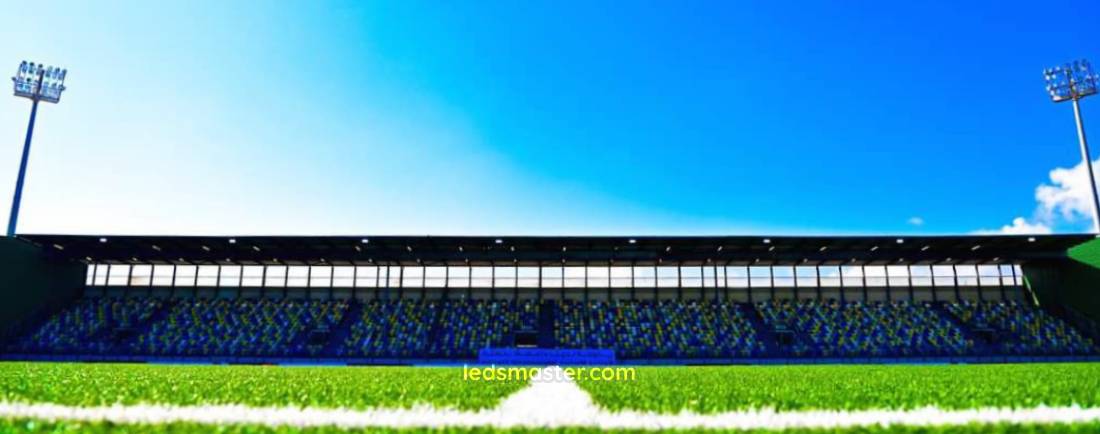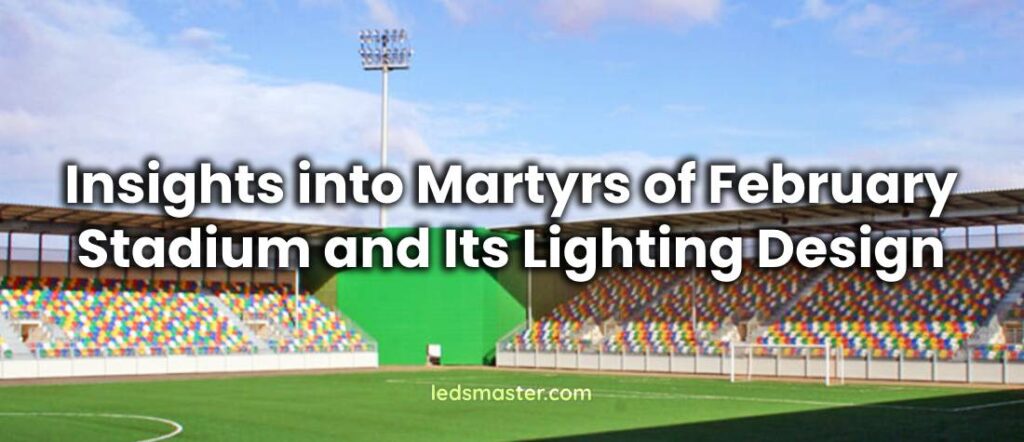Table of Contents
ToggleHistorical Background
The Martyrs of February Stadium, situated in Algiers, Algeria, stands as a testament to the nation’s dedication to sports and its rich history. Originally named the El Madani Stadium, its name was changed to honor the martyrs of the Algerian War of Independence. This historic venue has been a cornerstone in Algerian sports culture since its inauguration in 1972. It has played a crucial role in hosting national and international events, and its significance extends beyond sports to become a symbol of national pride and historical remembrance.
Capacity and Activities Held
The Martyrs of February Stadium, with its impressive seating capacity of approximately 60,000, stands as one of the largest and most prominent sports venues in Africa. This substantial capacity not only underscores its significance but also enables it to accommodate a wide range of events. Its vast seating arrangement allows for a high volume of spectators, enhancing the atmosphere for each event and contributing to a dynamic and energetic environment.
The stadium is renowned for hosting a variety of high-profile events. As the home ground for the Algerian national football team, it plays a pivotal role in the country’s sports culture. It regularly hosts international and local football matches, drawing fans from across the nation and beyond. The stadium’s design and size are well-suited for football, allowing for an immersive experience that enhances the excitement of the game. In addition to football, the venue is equipped to host significant athletic competitions, ranging from track and field events to rugby and other sports.
Beyond sports, the Martyrs of February Stadium is a versatile venue for large-scale concerts and cultural events. Its design allows for seamless adaptation to different types of events, from music festivals featuring international artists to national celebrations and public gatherings. This versatility not only broadens the scope of activities that can be held at the stadium but also ensures that it remains a central hub for entertainment and cultural expression in Algiers. By accommodating diverse events, the stadium contributes to the city’s cultural vibrancy and offers a platform for a wide range of experiences.

Economic Benefits
The economic benefits derived from the Martyrs of February Stadium extend far beyond the immediate revenue generated from ticket sales. The stadium acts as a catalyst for economic activity in Algiers, attracting thousands of visitors for each event it hosts. These visitors contribute significantly to the local economy by patronizing hotels, restaurants, and other businesses. The influx of tourists and sports enthusiasts creates a ripple effect that boosts demand for various services, generating additional revenue for the city’s hospitality and retail sectors.
Moreover, the presence of the stadium has a lasting impact on the local economy through job creation and infrastructure development. The need for event staff, security personnel, and maintenance crews generates employment opportunities, supporting local workers and contributing to economic stability. Additionally, the stadium’s presence has prompted improvements in surrounding infrastructure, including transport links and urban amenities. These enhancements not only benefit the stadium’s operations but also contribute to the overall development of the city, creating long-term economic advantages.
The stadium’s role in hosting high-profile events also elevates Algiers’ status as a destination for major sports and cultural activities. This heightened profile can attract further investment and tourism, reinforcing the city’s position as a key player in the regional and international event landscape. The economic benefits associated with the stadium highlight its importance as a central asset in Algiers’ economic and cultural framework.
Past Renovations
To maintain its status as a premier venue and meet evolving standards, the Martyrs of February Stadium has undergone several significant renovations over the years. These renovation projects have been essential in ensuring that the stadium remains at the forefront of sports and entertainment venues in Africa.
One of the most notable renovation efforts took place in 2009, a comprehensive project aimed at enhancing the stadium’s facilities and spectator experience. This extensive refurbishment included several key upgrades. The seating areas were modernized to improve comfort and accessibility, accommodating the needs of a diverse audience. An upgraded sound system was installed to enhance the auditory experience for spectators, ensuring that announcements and commentary were clear and audible throughout the venue.
Improvements to the pitch were also a major component of the renovation. The playing surface was upgraded to meet international standards, providing a high-quality field that supports optimal performance for athletes and contributes to the overall quality of events hosted at the stadium. These enhancements ensured that the stadium remained competitive in hosting major sports events and continued to offer a top-notch experience for both players and spectators.
In addition to these major renovations, ongoing maintenance and smaller-scale upgrades have been carried out to address evolving needs and technological advancements. These efforts reflect the stadium’s commitment to providing a world-class venue that meets the highest standards of safety, comfort, and functionality.

Lighting Design Features
Modern Lighting Solutions
The lighting design at the Martyrs of February Stadium plays a pivotal role in its functionality and aesthetic appeal. Central to this design is the use of cutting-edge lighting technology that ensures optimal visibility across the venue. The stadium is equipped with an advanced lighting system that delivers uniform illumination throughout the pitch, effectively minimizing shadows and ensuring that every corner of the field is brightly lit. This uniformity is crucial for both players and spectators, enhancing the overall viewing experience.
For night matches and television broadcasts, high-quality lighting is essential. The stadium’s lighting system is meticulously engineered to provide clear and vibrant visuals, which is vital for live coverage and media presentations. The advanced technology used ensures that the field is well-lit, facilitating excellent visibility for players and allowing spectators to enjoy an uninterrupted viewing experience. This focus on quality lighting not only supports the performance of athletes but also enhances the appeal of televised events, making the stadium a preferred choice for high-profile sports broadcasts.
Energy Efficiency
In recent years, the Martyrs of February Stadium has embraced energy-efficient lighting solutions, reflecting a broader commitment to environmental sustainability. The introduction of LED lighting throughout the venue marks a significant shift from traditional lighting systems. LEDs offer several advantages, including superior energy efficiency, a longer lifespan, and improved light quality. These benefits contribute to a reduction in operating costs and maintenance needs, making LEDs a cost-effective and environmentally friendly choice.
The transition to LED lighting also aligns with global trends towards reducing carbon footprints and promoting energy conservation. By adopting this technology, the stadium not only lowers its environmental impact but also sets an example for other venues in terms of sustainability. The energy efficiency of LEDs reduces the overall consumption of electricity, which helps in minimizing the stadium’s carbon emissions and supporting broader efforts to combat climate change.
Design and Aesthetics
The aesthetic aspects of the stadium’s lighting design are carefully considered to enhance the venue’s visual appeal. The lighting fixtures are strategically positioned to highlight the architectural features of the stadium, creating a visually captivating effect both during the day and at night. This thoughtful placement of lights not only illuminates the playing area but also accentuates the structural elements of the stadium, contributing to its iconic status.
The stadium’s lighting system includes dynamic and customizable options that allow for varied lighting schemes depending on the event. This flexibility enables the creation of different atmospheres, whether for a high-energy sports match, a cultural event, or a concert. The ability to adjust the lighting to match the nature of each event adds a layer of sophistication and excitement, enhancing the overall experience for spectators.
Moreover, the integration of dynamic lighting options allows for the use of color-changing effects and light patterns, which can be tailored to suit specific themes or celebrations. This adaptability not only improves the visual experience but also reinforces the stadium’s role as a versatile venue capable of hosting a wide range of events. By combining functional lighting with aesthetic design, the Martyrs of February Stadium achieves a balance that enhances both its operational effectiveness and its status as a landmark venue.
Technological Advancements
The Martyrs of February Stadium is at the forefront of innovation when it comes to lighting technology, thanks to its state-of-the-art lighting control systems. These advanced systems are designed to offer precise and dynamic management of illumination levels, ensuring that the lighting is always perfectly suited to the specific requirements of any event held at the venue.
The lighting control systems installed at the stadium provide the capability for real-time adjustments, allowing for immediate changes to the lighting conditions as needed. This flexibility is crucial for adapting to the diverse range of events hosted at the stadium, from sporting matches to concerts and cultural ceremonies. By allowing operators to adjust the lighting on-the-fly, these systems ensure that the venue can accommodate various lighting needs, enhancing both the functionality and the spectator experience.
One of the standout features of the stadium’s lighting technology is its ability to create special effects. Advanced controls enable the incorporation of color changes and light patterns, which can be tailored to fit the theme or mood of an event. For instance, during major football matches or significant public ceremonies, the lighting can be adjusted to display team colors, highlight key areas of the pitch, or create visually striking patterns that enhance the atmosphere. These effects not only elevate the aesthetic appeal of the venue but also contribute to the overall excitement and engagement of the audience.
In addition to these dynamic capabilities, the lighting control systems offer enhanced reliability and efficiency. The technology ensures that the lighting remains consistent and high-quality throughout events, minimizing issues related to light flickering or uneven illumination. This reliability is essential for maintaining the professional standards required for high-profile sports events and other large-scale activities.
Community Impact
The stadium’s lighting design extends beyond its functional and aesthetic benefits to impact the local community positively. The improved visibility and safety provided by modern lighting contribute to a more enjoyable and secure experience for spectators. Additionally, the stadium’s prominence and its enhanced visual appeal serve as a source of pride for the local community, reinforcing a sense of identity and connection to the venue.
Conclusion
The Martyrs of February Stadium, with its rich historical significance and impressive scale, stands as a beacon of Algerian pride and cultural heritage. Since its inception in 1972, this monumental venue has evolved into a central hub for sports, entertainment, and community engagement. The stadium’s capacity to accommodate approximately 60,000 spectators highlights its pivotal role in hosting a wide array of events, from thrilling football matches to major concerts and cultural gatherings.

